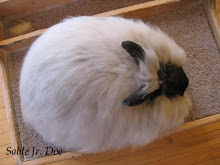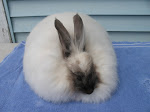--
another post from the old blog There is a wide assortment of criteria that people use to determine whether or not a rabbit should be added to their breeding herd. In some programs, several groups of rabbits are actually maintained for different purposes in categories that have separate and distinct requirements. For example, some Angoras make excellent woolers and are kept solely for that purpose, but they are poor prospects for breeding because they have mismatched toenails, skeletal problems, or some other characteristic that is highly heritable and could pose a problem for future generations. Alternatively, other rabbits may be excellent specimens on the showtable but poor candidates for the gene pool if they don't conceive well, are poor mothers, or have a less than adequate milk supply.
The question most breeders ask themselves repeatedly (and one that is by far the toughest to answer), is "Will this rabbit advance my breeding program or handicap it?" One of the most difficult things to learn when breeding livestock is where the line must be drawn in order to keep a bloodline moving forward and keep the herd as productive and vigorous as possible.
In rabbits (or any animal, for that matter), there are several categories that physical and genetic traits fall into. The first is composed of traits that should never be bred into a herd under any circumstance, the second contains those that could be incorporated under certain conditions, and the third lists qualities that are rarely serious enough to warrant culling or keeping an animal out of the gene pool, and which may even be desirable 99% of the time.
A list like this is something that would be different for every breeder. Respective categories would vary according to individual philosophies, personal goals, and personal preferences in the areas of color, wool, type, and production capability. A show person's threshold of tolerance for certain characteristics is invariably going to differ from the person who raises Angoras strictly for wool, and a Meat breeder's needs will invariably differ from those who show, breed wool, or raise rabbits as pets. An example of the traits in these categories for most breeders is as follows:
NEVER BREED-malocclusion
-split penis
-pigeon breast
-cowhocks
-white or mismatched toenails
-white spots, blazes, snips (in solid colors)
-does who kill/ cannibalize their litters
-does with inadequate or no milk supply
-does who repeatedly scatter litters/ have no mothering instinct
-biters/ rabbits with nasty temperaments
-disease (esp. Pasteurella)
-thin/ poor bone quality
-underweight (not nutrition-related)
Be aware that this list does not encompass various color genes that can infiltrate a herd and cause serious damage if not handled properly. Traits like this may include the Vienna gene, Steel, Harli gene, or the Dutch spotting gene.
SOMETIMES BREED-stray white hairs or tiny white spots/snips
-unrecognized colors
-'slightly' cowhocked
-low(er) shoulders
-overly hairy coat
-overly wooly coat
-cottony texture to coat
-more than 1/2 inch gap protrusion between guard hair and underwool
-pin bones
-medium density
-mediocre mothering skills/ milk supply/ litter sizes/ conception rates
-'moodiness' that does not result in biting (esp. in mature does)
BREED READILY-correct color but with varying intensity
-good temperament/ inquisitive personality
-solid type/ solid bone
-aggressive sires/eager breeders/receptive does/ excellent mothers
-rapid weight gain (5 lbs. @ 12 weeks for commercial breeds, etc.)
-density, good texture, high yield, excellent overall balance (in wool)
-prepotent bucks/does (rabbits who readily pass on their best traits)
-supreme health and vigor
-ability to maintain condition and a long prime period
-6 months or more holding time between molts
-unfussy (appetite, behavior, and general disposition)
These are only a few examples of traits in each category and I know I've missed some, but it is important to realize that these groupings are not definitive, but rely in large part on the goals of the individual breeder, the breed being raised (since different breeds have different requirements), and the short and long term goals that you have set in your rabbitry.
In my own situation I fall into the stricter end of this breeding spectrum. I would never knowingly breed a rabbit with any of the characteristics listed in the first group, and at this point I wouldn't normally breed rabbits falling into the second group, either. That being said, there are times when I have deliberately neglected a certain trait in order to fall back and fix another one, and when first starting out as a breeder there is little choice but to work with what one has in order to progress to something better. Over the past few years I worked hard to improve wool balance and quality, but one day I realized that I had been sacrificing type (over the hind quarter especially) in order to achieve it, so I stopped, backed up, and thought about how to fix the problem. The majority of points in every angora breed are on the wool, but the FA in particular cannot compete on a National level without being strong in both categories, so this was something that had to be corrected. For the time being I have chosen to ignore the wool a bit in order to focus on better type (especially since type is hard to set but wool improves much more quickly), To this end I brought in the F2 NZ/FA Cross from Elaine who is extremely strong in the hindquarter, and that should help to correct the problem.
A last word about color, also. When I began breeding in the beginning I felt that color was extremely important, almost to the exclusion of everything else. A few more years down the road I learned more about genetics and began to see the rabbit as a total package rather than a sum of it's individual parts, and realized that color could be sacrificed at times in order to fix a more important wool or type trait. I still would not knowingly breed in a problematic color gene (such as the ones listed above), and I would never breed snips, spots, or white/mismatched toenails, but what I WOULD do if the more important goals of my breeding program called for it is breed incompatible or outright unrecognized colors if they had the type and wool that I was looking for. A rabbit with outstanding type who showed up in a color that was not recognized or registerable would be incorporated into the breeding program simply because that is an easy fix at this point, and the line would benefit immensely as a result. Once a herd evolves to the point where type and wool become set, then THAT is the time to nitpick and pay strict attention to details such as color, focusing strictly on like to like combinations that improve the overall quality and intensity. Maybe you could even say that it is important to focus on the inside of a rabbit first (bone, skeletal quality, type detail), and progress to the outside later with density of wool, texture, and finally color.


























